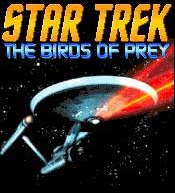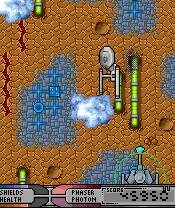Given that the last four decades have seen so many significant changes in the Star Trek universe--to the point that today's hip, reconfigured franchise rarely turns to the original show's plot clichés for recourse--one could easily assume that Captain James T. Kirk, his valiant crew, and the USS Enterprise had finally lapsed into a drowsy obscurity, perhaps on the order of I Love Lucy. Instead, Kirk, Spock, and the rest of the crew have barely lost any momentum over their years of questing through the galaxy, and now they're popping up again in a few new licensed mobile games from Jumbuck. Star Trek: The Birds of Prey is a top-down shooter in the vein of games like Xevious and Raiden, which casts the Enterprise (somewhat inaccurately) as a combat-ready space fighter. Fortunately, this is such a good action game that you wouldn't even notice which kind of famous spaceship you were piloting, if not for the perfect Star Trek tonality.
Star Trek: The Birds of Prey tells the story of Kirk's efforts to foil a conspiracy hatched by two classic races of spacefaring nasties. That's right, the Klingons and Romulans are up to all their old tricks: attacking Federation colonies, sacking space stations, and even kidnapping Dr. McCoy. Kirk and the gang respond by taking the fight to the bad guys through six long levels, courtesy of the Enterprise's potent, 23rd-century weapons systems. Along with a steady hand on the tiller, they'll be just enough to get you through this adventure, which will test your skill by inundating the Enterprise with space debris, ground- and space-based drones, and Klingon and Romulan warships of all varieties.
Even though the Enterprise handles more like a Harrier jump jet than an interstellar exploratory vessel in this game, you'll love the re-creation of the phasers, shields, and photon torpedoes--and how they are tactically interwoven, making each useful in its own way. Your phasers shoot a thin beam of energy straight ahead of your ship for about a second. This beam isn't a discreet attack, however--the longer you focus it on a target, the more damage it will do. A fully applied phaser blast packs enough punch to destroy small meteors and gun turrets, but the beam is so narrow that you have to aim really carefully and remain stationary to apply its full effect to small targets. Furthermore, your phaser banks will deplete if you try to use them in rapid succession. These clever limiting factors make judicious phaser use a vital part of this game. Luckily, using this basic attack never feels oppressively difficult. The beam will auto-aim to focus on a moving enemy, if you're close enough, and the phaser banks recharge fast enough to keep you safe if you play your cards right.
Also, you can count on properly applied photon torpedoes and shields to get you out of an emergency situation. You have a limited number of torpedoes, and they move very slowly, but they also home in on the nearest enemy and are tremendously powerful. In fact, they'll destroy most unshielded enemy ships in one blow. On defense, your shields will block most enemy shots, which deplete your shield meter according to their strength. If you don't take any hits for a few seconds, the meter will quickly recharge--but if your shields go down completely, any subsequent damage will be taken out of your persistent health meter. And shields are no good for collisions, which take huge chunks out of your health. While its controls aren't cumbersome, the Enterprise is pretty big, which makes last-minute dodging fairly difficult. Survival in Star Trek: The Birds of Prey is a matter of confronting threats in advance, blazing a trail with your weapons, and then accelerating through the holes.
Thanks to the game's interesting level designs, this process never really gets old. The Birds of Prey starts out conventionally enough, but pretty soon you'll be dealing with some pretty novel environmental factors. For example, there are levels that scroll in stops and starts, as well as wormhole sequences that disrupt your controls and damage your ship if you touch the sides of the screen. There's an asteroid-field level where you can accelerate through tiny holes in chains of asteroids, and on a later level you'll even steal a Romulan cloaking device and try to sneak past a mazelike array of sentry turrets. If you sustain any damage in this sequence, your camouflage will temporarily fizzle, making you an easy target. The levels are surprisingly long, and often consist of multiple sequences that are broken up by conversation with your crew or enemies. One peccadillo crops up with the game's power-up system, which feels a little inadequate at times. You'll occasionally be provided with power-up capsules that restore your health or photon torpedoes--but the power-ups actually oscillate slowly between the two commodities, meaning that you may not get what you need if you grab them at the wrong time. Add this to the infrequency of the power-ups' appearance and the fact that you get only three continues per game, and you may find yourself wondering if the game is unnecessarily challenging, even on the "ensign" level.

On our test handset, the Nokia 6600, Star Trek: The Birds of Prey does a superior job of presenting itself as both a fast-paced action game and a chapter in the Star Trek continuum. For one thing, likenesses of all the major characters from the original show--from Kirk on down to Uhura--made it into the game, and they help tell the story with unique bits of dialogue that fit in very well with their established characters. For another, the ship models look great. The Enterprise and its opponent ships are beautifully rendered against multiple backgrounds, and their energy weapons actually appear to pulse and glow like they did in the show. You can even watch a Klingon shield break down bit by bit under the force of your phasers. The manner in which the Enterprise tilts on an angle and flies horizontally across the screen is a little odd, but it works anyway. The game runs at a brisk pace throughout actual gameplay--though, strangely, it does experience periods of slowdown during the dialogue sequences at the beginning of each level. The music and sounds are first-rate, from the authentic title theme to the phaser sound effects and explosions. The developer obviously put a lot of effort into making sure this game looked and sounded like a Star Trek product through and through, and it's really paid off.
Star Trek: The Birds of Prey is one of those exceedingly rare media-licensed mobile games that flies in the face of convention. It's not only a pleasant surprise--it's a spectacular action game that is easily one of the best shooters on the mobile platform. Even if you're an action gamer who can't stand Star Trek, you'd be doing yourself a disservice if you didn't try this one out.
